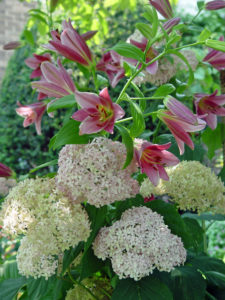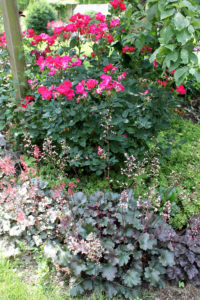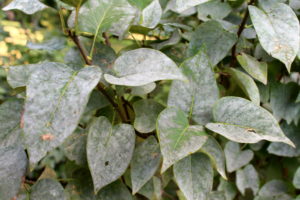Go Ahead, Push That Shade Envelope
August 22nd, 2017
If you’re dealing with a mostly shaded yard, you might be inclined to write off the many plants with “full sun” on the label.

Check out these sun-loving lilies doing quite well in the shade of a tree alongside smooth hydrangeas.
Don’t back off completely, though. Even some of the most sun-loving plants will do reasonably well in some shade.
They might not bloom as fully, and they might get “leggy” or lean to the light, but they’ll probably perform better than you think.
I stumbled into this realization years ago when I transplanted a couple of then-new Knock Out roses from my mom’s yard before she went into assisted living.
The only place I had to go with them was under a dogwood tree. It was pretty much shade all day.
I figured they’d live but not amount to much in the bloom department.
Surprise!
The roses actually filled out reasonably well and even bloomed at half the rate of a full-sun Knock Out – which, if you’ve grown Knock Outs, know that’s still good.
A few years later, I got a trial packet of pink Oriental lilies from Brent and Becky’s Bulbs (my favorite bulb company). Again, with nowhere else to go (this happens a lot in my yard), I crammed them under a tree in an opening in the middle of three smooth hydrangeas.
I held out little hope of high performance. But at least the lily bulbs were in the ground.
The next June, those lilies poked above the hydrangeas and bloomed beautifully in concert with the showy light-pink hydrangea orbs.
It was a brilliant combination, conceived in ignorance. The surrounding hydrangeas even propped up the 3½ -foot-tall lilies.
As I found out in these cases, a benefit of pushing the shade envelope is that you open a whole new world of strange bedfellows.
Variegated weigela underplanted with sweet woodruff? Check.
Leafy hostas with strappy daylilies? Check.
Spring-blooming azaleas surrounded by summer-blooming petunias? Check.
Don’t be afraid to experiment. If a sun-lover clearly isn’t happy living on the dark edge, you can always move it into more light.
With annuals, they’re only going to live one season anyway. If it doesn’t work out, cross your experimental species off the list and go back to begonias.
Three things to keep in mind:
1.) Sun-lovers are likely to be leggier and floppier than in bright light. Counteract that by choosing compact varieties, by staking/supporting the plants, and for later-bloomers, by trimming them back by one-third to one-half around Memorial Day.
2.) Sun-lovers may go downhill over time. This can happen because they’re not getting the amount of recharging sunlight that their genetics require.
You may be able to salvage them before death by transplanting them into a sunnier spot. Or just replace them. Even if you only get four or five years out of a perennial, that’s still not a bad investment.
3.) Sun-lovers may be more prone to fungal leaf diseases, such as powdery mildew or leaf spot in shade.
The main reason is that leaves don’t dry as quickly in shadier spots, aiding the humid conditions that fuel many infections. Shade plants have adapted to deal with this better than sun-habitat natives.
Here’s a list of sun plants worthy trying in something less than full sun, such as part-day shade or in the dappled light under trees:
Evergreens: Boxwood, cherry laurel, globe arborvitae, Hinoki cypress, holly, nandina, yew
Shrubs: Abelia, beautyberry, blueberry, bush honeysuckle, butterfly bush, clematis, deutzia, ninebark, rose of sharon, shrub rose, spirea, St. Johnswort, variegated caryopteris, variegated weigela, Virginia sweetspire
Perennials: Betony ‘Hummelo,’ black-eyed susan, campanula, coneflower, coralbells, creeping phlox, creeping veronica, daylily, hardy geranium, leadwort, liatris, lily, peony, salvia, shasta daisy, Siberian iris
Annuals: Alyssum, angelonia, blue salvia, calibrachoa, cleome, euphorbia, geranium, nicotiana, petunia, scaevola, sweet potato vine, verbena
Read George’s PennLive garden column on how it’s possible to grow vegetables in shade.









